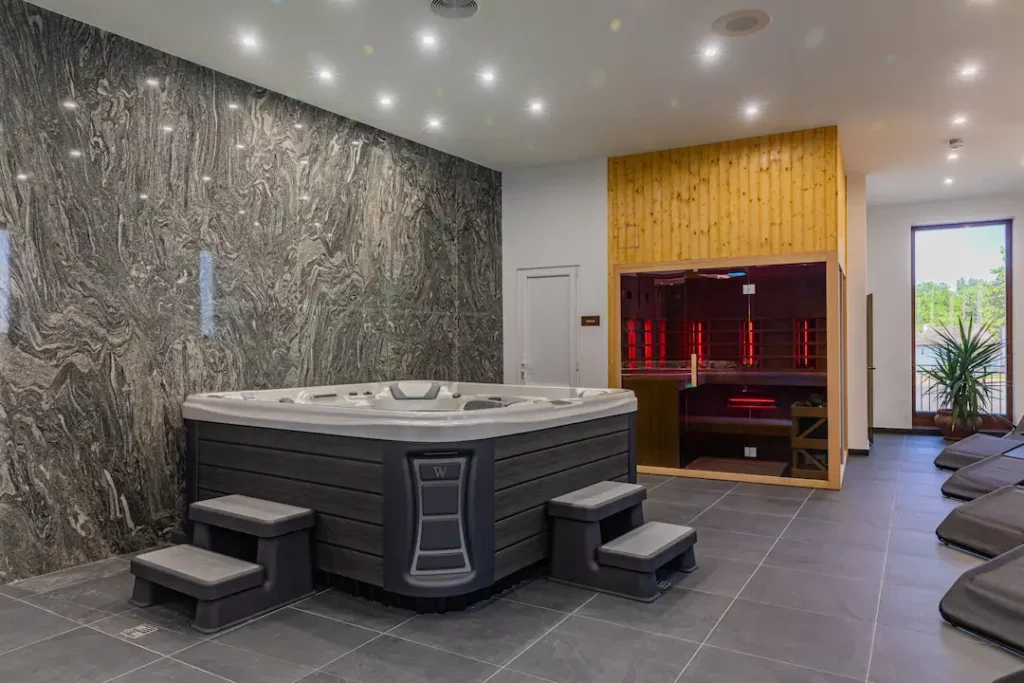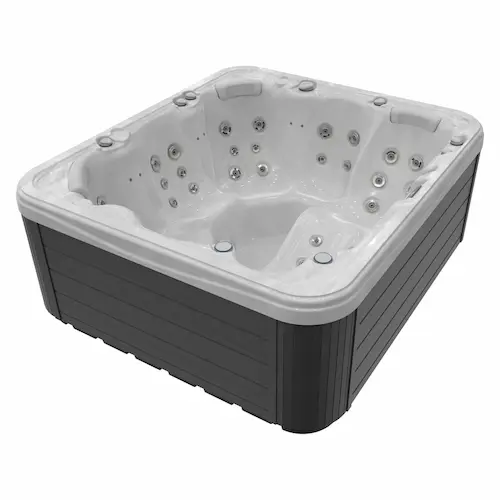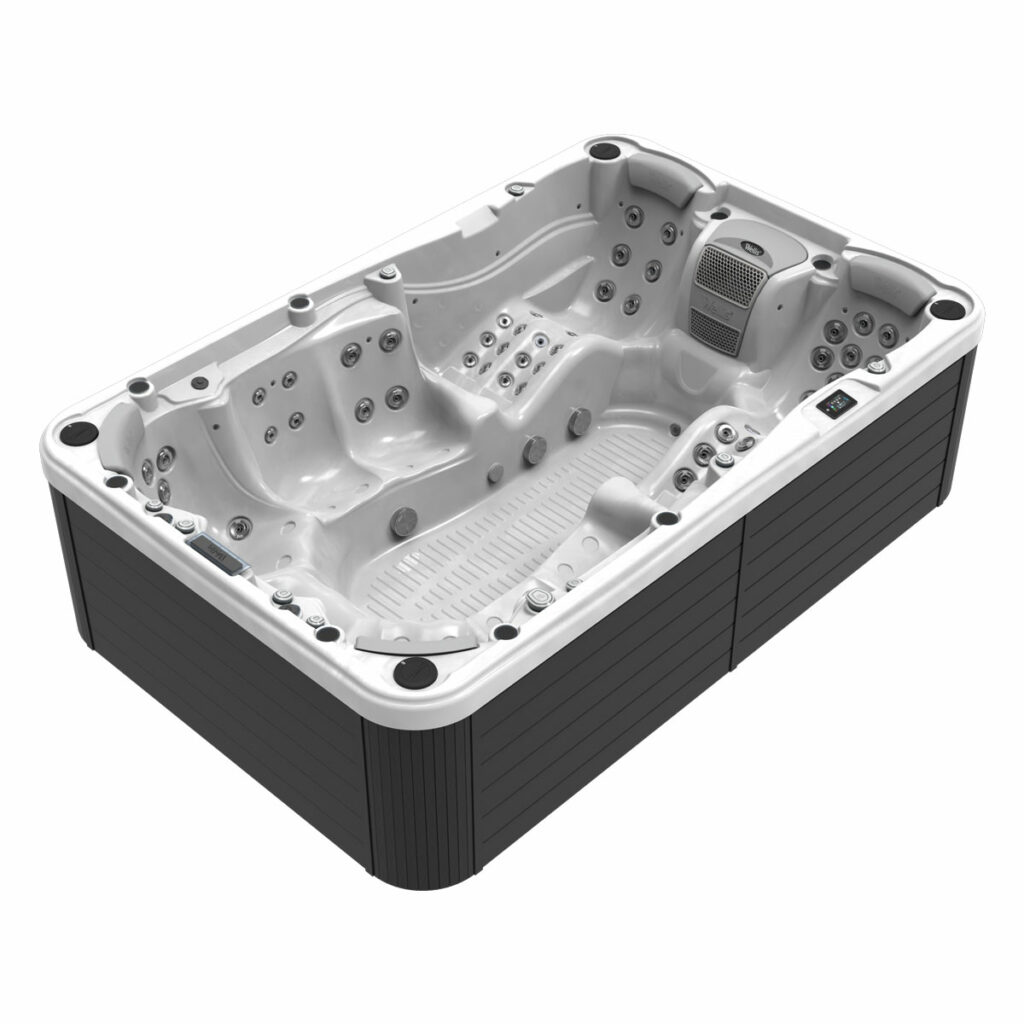Imagine being able to enjoy your hot tub any time of the day or night - regardless of the weather. An indoor hot tub offers privacy, convenience, and luxury, but the process of purchasing and installing one involves several important considerations. Check out these things you should consider before installing an indoor hot tub!
Wellis Spas is a leader in hot tub and swim spa manufacturing around the world, with expertise in both indoor and outdoor installation. Here, we’ll explore the factors you should keep in mind when buying and installing an indoor hot tub.

Table of Contents
Can I Install a Hot Tub Indoors?
First things first: Is an indoor hot tub even possible? Yes! You can install a hot tub indoors. However, it requires careful planning, including structural assessments, proper ventilation, plumbing, and specific electrical requirements. Compliance with local regulations is crucial, and you must ensure your home can support the added weight and moisture control needed for an indoor hot tub.
If you do decide that an indoor hot tub is right for you, the benefits are well worth that planning.
Benefits of Indoor Hot Tubs
An indoor hot tub is more than just a luxurious addition to your home; it's a gateway to relaxation, health, and well-being. Wondering if an indoor hot tub is the right call for you? Let’s explore some of the pros before we delve into the cons.
Year-Round Relaxation
One of the most compelling benefits of an indoor hot tub is the ability to enjoy it throughout the year. Unlike outdoor hot tubs that are weather-dependent, indoor hot tubs offer year-round access, allowing you to unwind and de-stress, regardless of the season or weather conditions.
Enhanced Privacy
Indoor hot tubs provide a greater level of privacy compared to outdoor ones. You can soak in peace without worrying about prying eyes or nosy neighbors, creating a more intimate and comfortable experience.
Therapeutic Benefits
The warm, buoyant waters of a hot tub offer a range of therapeutic benefits. Regular use can help alleviate muscle tension, reduce joint pain, and improve circulation. The combination of heat and buoyancy can also promote better sleep, making it an excellent option for those struggling with insomnia.
Stress Relief
A soak in an indoor hot tub can be a highly effective stress-relief strategy. The warm water relaxes muscles and triggers the release of endorphins, natural mood lifters that can help combat stress and anxiety.
Improved Skin Health
Hot tubs are known to improve skin health. The heat and steam help open up pores, allowing for a deep cleanse. This can lead to smoother, clearer skin and may even provide relief for conditions such as acne and psoriasis.
Family and Social Gathering Space
An indoor hot tub can serve as a focal point for family and social gatherings. It provides a unique space for bonding, relaxation, and quality time with loved ones. Whether it's a romantic evening for two or a gathering with friends, your indoor hot tub can be the centerpiece of memorable moments.
Convenience and Accessibility
Indoor hot tubs are incredibly convenient. You don't have to brave the elements or endure long walks to reach your relaxation spot. Plus, with the ability to control the temperature and jets easily, you can tailor the experience to your preferences.
Energy Efficiency
Modern indoor hot tubs are designed with energy efficiency in mind. They are well-insulated and often come with energy-saving features, making them more cost-effective to operate over time.
Aesthetic Appeal
An indoor hot tub can elevate the aesthetics of your home. With various design options, you can seamlessly integrate it into your indoor space, creating a visually appealing and harmonious environment.
Enhanced Property Value
Investing in an indoor hot tub can increase the overall value of your property. Potential buyers may see it as a valuable addition, which could make your home more attractive on the real estate market.
Challenges of Indoor Hot Tubs
Indoor hot tubs clearly offer a host of benefits, including year-round relaxation and privacy. However, it's essential to consider the potential drawbacks before taking the plunge.
Structural Considerations
Indoor hot tubs are heavy, even when empty, and their weight significantly increases when filled with water and occupants. Installing one requires a thorough structural assessment of your home's foundation and floor to ensure it can support the added load. This can be a costly and time-consuming process.
Ventilation Challenges
Hot tubs generate heat and moisture, creating a high-humidity environment. Without proper ventilation, this moisture can lead to mold and mildew growth, potentially damaging your home and impacting indoor air quality. Effective ventilation systems are crucial but may require additional investments.
Space Constraints
Indoor spaces typically have limited room for maneuvering. Careful measurement and planning are necessary to ensure that the hot tub fits comfortably within the available space while allowing for safe access, maintenance, and clearances around the tub.
Hot Tub Installation Costs
Installing an indoor hot tub can be costly. Beyond the initial purchase price, you'll need to budget for structural modifications, plumbing, electrical work, ventilation systems, and ongoing operational expenses like heating and maintenance. These costs can add up quickly.
Privacy Trade-Offs
While indoor hot tubs offer increased privacy compared to their outdoor counterparts, they may lack the open-air experience that many people enjoy. Some individuals prefer the sensation of being outdoors while soaking in a hot tub, which indoor setups cannot replicate.
Maintenance Challenges
Maintaining an indoor hot tub can be more demanding than an outdoor one. Indoor environments are prone to accumulating dust and debris, which can affect water quality. Regular cleaning, water treatment, and filter replacement are essential tasks that require time and effort.
What to Consider Before Installing an Indoor Hot Tub
Installing an indoor hot tub is a luxurious addition to your home that can provide year-round relaxation and rejuvenation. Once you’ve decided on it, however, the project will require careful planning, attention to detail, and adherence to safety regulations.
1. Space and Location
The first step in this journey is identifying the right location within your home for the hot tub. Measure the available space carefully to ensure it can accommodate the hot tub comfortably. Consider factors such as access, clearances, and whether the location meets any local building codes or regulations.
2. Structural Assessment
Before purchasing your indoor hot tub, consult with a structural engineer or a qualified contractor to evaluate whether your home's floor and foundation can support the added weight of the hot tub, water, and occupants. Reinforcements may be necessary, and it's crucial to address this issue upfront to prevent any structural problems in the future.
3. Ventilation and Moisture Control
Proper ventilation is vital for maintaining indoor air quality and preventing moisture-related issues. Hot tubs generate steam and humidity, which can lead to mold and mildew problems if not adequately managed. Plan for an effective ventilation system and, if needed, a dehumidifier to maintain a comfortable and healthy indoor environment.
4. Plumbing and Electrical Requirements
Indoor hot tubs require plumbing and electrical connections. Ensure that your home's plumbing system can handle the additional demand, and hire a licensed electrician to install the electrical components safely. Consider the location of existing electrical outlets and water supply lines when deciding where to place the hot tub.
5. Permits and Regulations
Local building codes and regulations can vary widely, so check with your local building department to determine if permits or approvals are needed for your indoor hot tub installation. Complying with these regulations is essential to ensure a safe and legal installation.
6. Flooring and Waterproofing
Hot tubs involve water, so choose flooring and waterproofing materials that can withstand moisture and are easy to clean. Common choices include ceramic tiles, vinyl, or specialized hot tub pads. Prioritize slip-resistant options to prevent accidents.
7. Accessibility and Safety
Consider how you and your family will access the hot tub safely. Install handrails, non-slip surfaces, and proper lighting to prevent accidents. Safety covers and locking mechanisms are also essential to restrict access when the hot tub is not in use, especially if you have children or pets.
8. Maintenance and Budget
Owning an indoor hot tub comes with ongoing maintenance responsibilities. Budget for water treatment chemicals, filters, and regular cleaning. Additionally, account for the cost of heating the hot tub and potential repairs. Understanding these long-term expenses is crucial to avoid any financial surprises.
9. Aesthetic Integration
An indoor hot tub should complement your home's aesthetics. Explore design options and consider how the hot tub can be integrated into your indoor space seamlessly. Choose finishes and materials that match your interior decor.
Make your indoor hot tub an aesthetic highlight of your home. Coordinate the design elements, such as color schemes and finishes, to match your interior decor. You can create a spa-like ambiance with carefully chosen lighting, comfortable seating, and soothing artwork.
Choosing the Best Indoor Hot Tub: Types and Sizes
Selecting the right type and size of hot tub is crucial to ensure it fits seamlessly into your indoor space while meeting your specific needs.
Types of Hot Tubs
When choosing a hot tub for indoor installation, consider the following types:
In-Ground Hot Tubs
In-ground hot tubs are a popular choice for indoor installations. They are often custom-built and integrated into the floor, providing a seamless and luxurious appearance. These hot tubs can be made of various materials, including concrete, tile, or acrylic, and they offer a range of customization options.
Pros:
- Aesthetic appeal and customization.
- Can be seamlessly integrated into the indoor space.
- Often comes with built-in seating and water features.
Cons:
- Typically more expensive due to custom construction.
- May require significant structural modifications.
Above-Ground Hot Tubs
Freestanding hot tubs are versatile and come in various sizes and designs. They are self-contained units that can be placed anywhere in your indoor space. Freestanding hot tubs are available in acrylic, roto-molded, and wooden models.
Pros:
- Easier to install than in-ground hot tubs.
- A wide variety of sizes and shapes to choose from.
- Generally more affordable.
Cons:
- May not offer the same level of customization as in-ground models.
- The exterior may require additional finishing to match your decor.
Hot Tub Size
Selecting the right hot tub size for your indoor hot tub is essential for both comfort and functionality. Here are some considerations:
Two-Person Hot Tubs
Two-person hot tubs are compact and ideal for small indoor spaces or couples looking for an intimate soaking experience. These tubs typically measure around 5-6 feet in length and are space-efficient.
Pros:
- Perfect for smaller indoor areas.
- Energy-efficient due to their smaller water capacity.
- Cozy and intimate for couples.
Cons:
- Limited seating capacity.
- May not accommodate larger groups.
Four- to Six-Person Hot Tubs
Hot tubs designed for four to six people are a popular choice for indoor installations. They strike a balance between space efficiency and socializing capacity. These tubs typically measure 6-7 feet in length.
Pros:
- Suitable for small gatherings and family use.
- More seating options for various body types.
- A good balance between size and energy efficiency.
Cons:
- Require more indoor space than two-person tubs.
- May require more heating and maintenance due to the larger water volume.

Milano Life P&P Hot Tub
The Milano Life P&P hot tub provides 4 comfortable seats and an incredible lounger, making it one of the most capable plug and play hot tubs for sale
Large Hot Tubs (Seven or More Persons)
For those with ample indoor space and a desire to entertain, larger hot tubs designed for seven or more people are an excellent choice. These spacious tubs can measure 8 feet or more in length.
Pros:
- Ideal for entertaining guests or larger families.
- Multiple seating options and configurations.
- Spacious and comfortable for all users.
Cons:
- Demand a significant amount of indoor space.
- Higher water and energy consumption can affect operating costs.

Olympus Hot Tub
As many as 9 people can comfortably relax in the Olympus hot tub that meets the highest needs. You may also enjoy the beneficial effects of warm water in this hot tub with 7 seats, 2 recliners, and a bevy of jets, ensuring a massage experience greater than ever before.
FAQ: Indoor Hot Tubs
Do you need ventilation for an indoor hot tub?
Yes, you typically need ventilation for an indoor hot tub. Proper ventilation is essential for several reasons when you have an indoor hot tub:
- Moisture Control
- Indoor Air Quality
- Comfort
- Structural Protection
To ensure that your indoor hot tub space remains comfortable, safe, and free from moisture-related issues, it's advisable to install an effective ventilation system. This system may include exhaust fans, dehumidifiers, or a combination of both, depending on the size of your hot tub and the level of humidity control required. Consulting with a professional or HVAC specialist is recommended to design and install an appropriate ventilation solution for your indoor hot tub area.
What kind of flooring should I use for an indoor hot tub room?
Using ceramic porcelain tile or sheet vinyl for the room's flooring is crucial, while carpeting should be avoided. Carpets can encourage mold growth in damp areas, whereas tile flooring is not only easier to clean but can also be treated with bleach to eliminate mold.
Is it safe to put a hot tub on a balcony?
Putting a hot tub on a balcony can be risky and requires careful consideration. Balconies are not typically designed to support the weight of a hot tub, which can be substantial when filled with water and occupants. It's crucial to consult with a structural engineer or a professional to assess whether the balcony can handle the load and if any reinforcements are needed.
Additionally, consider the balcony's size and access points, as hot tubs require adequate space for installation and maintenance. Ensure that the balcony's railing and structural components are sturdy and meet safety standards. Furthermore, check with your building management or homeowners' association to confirm that hot tub installation is allowed and complies with any regulations. Safety is paramount, and a properly installed hot tub on a balcony can be feasible if all necessary precautions and structural requirements are met.
Final Word: What to Consider Before Installing an Indoor Hot Tub
With attention to detail and a thoughtful approach to design, your indoor hot tub can become a luxurious centerpiece in your home that you'll cherish for years to come.
Key takeaways:
- Carefully consider the size and type of hot tub that will work best in your space.
- When looking for a hot tub for sale, also consider the hot tub manufacturer - choose a trusted hot tub brand.
- Indoor hot tubs provide benefits like stress relief, convenience, energy efficiency, and elevating your space.
- Some of the most important things to consider when installing an indoor hot tub include ventilation and moisture control, plumbing and electrical requirements, and structural considerations.
For any indoor hot tub questions, use our dealer locator, shop online, or contact Wellis® Spa at 844-4-WELLIS. You can also check out our full hot tub buying guide, to start planning your indoor oasis today!
You can even schedule a test soak in one of our Wellis hot tubs at participating hot tub dealers. Simply call ahead to schedule a test soak. Find a Wellis hot tub dealer near you to get started! Use our hot tub store locator or call us at 844-4-WELLIS.

![Wellis Hot Tub Store in [cityst]](https://wellisspa.com/wp-content/uploads/Wellis-Hot-Tubs-in-Raleigh-Hero.webp)
